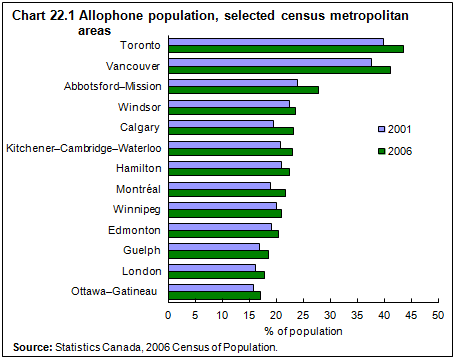Languages
Archived Content
Information identified as archived is provided for reference, research or recordkeeping purposes. It is not subject to the Government of Canada Web Standards and has not been altered or updated since it was archived. Please "contact us" to request a format other than those available.
Related information
In 2006, Canada had 18.1 million people whose mother tongue was English, 6.9 million whose mother tongue was French, and 6.3 million whose mother tongue was neither English nor French.
The proportion of anglophones, Canada's predominant language group, is shrinking steadily as the proportion of allophones—people whose mother tongue is neither English nor French (Canada's two official languages)—is increasing. From 1981 to 2006, the anglophone share of the total population declined from 61% to 58%.
Francophones are the largest language minority in the provinces, except for Quebec, where they are the majority language group. In 2006, French was the mother tongue of 22% of Canadians, and close to 80% of Quebecers. From 2001 to 2006, francophones had the lowest rate of population growth, at 1.6%, compared with 3.0% for anglophones and 18.0% for allophones.
Cree, Inuktitut and Ojibway were the three most commonly spoken Aboriginal languages in 2006, with 69% of Inuit, 29% of First Nations people and 4% of Métis able to converse in an Aboriginal language.
A growing allophone population
Because of the substantial increase in immigration since the mid-1980s, the proportion of allophones in the population has more than doubled since 1981, growing from less than 10% to 20% in 2006.
According to projections of the diversity of the Canadian population, the allophone population could continue to increase from 7 to 11 times faster than the rest of the population. In fact, it could nearly double again to comprise around 29% to 32% of the total population by 2031.
In 2006, 87% of Canada's allophones were living in census metropolitan areas (CMAs). This percentage of allophones is expected to increase: 91% of the country's allophones are projected to be living in a CMA by 2031.
People whose mother tongue is a Chinese language is the largest group of allophones in Canada. In 2006, this group accounted for 3% of the total population and 16% of the allophone population.
Official-language minorities
Francophones outside Quebec are scattered across Canada with large numbers residing in Ontario and New Brunswick.
People with French as their mother tongue made up 4.2% of Ontario's total population in 2006. One out of four of these francophones were living in Ottawa, and about the same proportion were located in northeastern Ontario.
Ontario's francophones speak French mostly at home and with friends. They use it less often in interactions with institutions and stores and for media consumption. Use of French in the various domains of the public sphere varies by region; French is more common in eastern Ontario.
In 2006, English was the first official language spoken by 995,000 people in Quebec, or 13.4% of the province's population. In other provinces, language transfers—when the language a person uses most often at home is not their mother tongue—are made primarily toward English by allophones. In Quebec, such transfers are equally divided between French and English. In 2006, 50% of allophones who had made a language transfer were mainly using French at home while 48% were mainly using English.
Nearly 92% of Quebec's anglophone population is clustered in three regions: Montréal, the Outaouais, and in the Eastern Townships and southern Quebec. Anglophones in the Montréal CMA make up 80.5% of Quebec's total English-speaking population.
Quebecers whose first official language is English tend to use their language in both the public and private spheres. Among Quebecers who speak English, French and a third language, English is usually used for media consumption, while French is used in the public sphere and a third language is used at home.
Language and income
Anglophones are under-represented in Quebec's public service workforce, whereas francophones are over-represented. In addition, anglophone men in Quebec have a lower median annual income than their francophone counterparts ($4,000 less).
Income disparities are greater among anglophone Quebecers than among francophone Quebecers. For example, a higher proportion of anglophones than francophones had an income above $100,000 in 2006, and at the same time a higher proportion of anglophones than francophones were living in low-income circumstances.
- Date modified:

